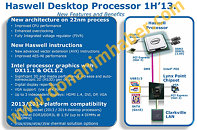- Joined
- Oct 9, 2007
- Messages
- 47,598 (7.45/day)
- Location
- Dublin, Ireland
| System Name | RBMK-1000 |
|---|---|
| Processor | AMD Ryzen 7 5700G |
| Motherboard | Gigabyte B550 AORUS Elite V2 |
| Cooling | DeepCool Gammax L240 V2 |
| Memory | 2x 16GB DDR4-3200 |
| Video Card(s) | Galax RTX 4070 Ti EX |
| Storage | Samsung 990 1TB |
| Display(s) | BenQ 1440p 60 Hz 27-inch |
| Case | Corsair Carbide 100R |
| Audio Device(s) | ASUS SupremeFX S1220A |
| Power Supply | Cooler Master MWE Gold 650W |
| Mouse | ASUS ROG Strix Impact |
| Keyboard | Gamdias Hermes E2 |
| Software | Windows 11 Pro |
Some time in 2013, Intel will launch its new processor architecture, codenamed "Haswell", which will go on to succeed "Ivy Bridge". More than an year away from its market entry, Haswell has already been exhaustively documented, but not many got into the details about its embedded graphics processor. That is, until now. A new internal slide sourced by DonanimHaber details the integrated GPU (iGPU), it appears like Intel has solid plans for home users.
To begin with, Haswell's iGPU will be DirectX 11.1 compliant, which means it will take advantage of API optimizations that improve performance, for typical desktop usage scenarios. Apart from support for a new DirectCompute architecture, it will also support OpenCL 1.2, which speeds up certain GPGPU-optimized applications. More importantly, the iGPU will be designed around a new stereoscopic 3D standard called Auto-Stereoscopic 3D (AS3D), which will take the likes of Blu-ray 3D acceleration, stereo 3D photos, etc., to the masses. Currently, it takes at least an entry-level GeForce or Radeon GPU to for acceptable performance with stereo 3D.

Another significant change is what Intel refers to as "digital display repartition". Until now, Intel processors with embedded graphics relied on the PCH to perform all display I/O functions, the iGPU communicates to the PCH over the Flexible Display Interface (FDI), a special data link dedicated to this function. With Haswell, digital display outputs (such as DVI, HDMI, DisplayPort), will be wired directly to the CPU socket, while analog display (such as D-Sub), will be handled by a RAMDAC located in the PCH, to which a digital signal is sent over FDI. This design ensures there's no performance bottleneck with higher resolution digital displays, while at the same time, ensuring analog display quality isn't affected by the RAMDAC being located in the GPU die, where it's bound for interference by some pretty high-current circuits.
View at TechPowerUp Main Site
To begin with, Haswell's iGPU will be DirectX 11.1 compliant, which means it will take advantage of API optimizations that improve performance, for typical desktop usage scenarios. Apart from support for a new DirectCompute architecture, it will also support OpenCL 1.2, which speeds up certain GPGPU-optimized applications. More importantly, the iGPU will be designed around a new stereoscopic 3D standard called Auto-Stereoscopic 3D (AS3D), which will take the likes of Blu-ray 3D acceleration, stereo 3D photos, etc., to the masses. Currently, it takes at least an entry-level GeForce or Radeon GPU to for acceptable performance with stereo 3D.

Another significant change is what Intel refers to as "digital display repartition". Until now, Intel processors with embedded graphics relied on the PCH to perform all display I/O functions, the iGPU communicates to the PCH over the Flexible Display Interface (FDI), a special data link dedicated to this function. With Haswell, digital display outputs (such as DVI, HDMI, DisplayPort), will be wired directly to the CPU socket, while analog display (such as D-Sub), will be handled by a RAMDAC located in the PCH, to which a digital signal is sent over FDI. This design ensures there's no performance bottleneck with higher resolution digital displays, while at the same time, ensuring analog display quality isn't affected by the RAMDAC being located in the GPU die, where it's bound for interference by some pretty high-current circuits.
View at TechPowerUp Main Site





 interesting aside itheir BTA, so intel have sort of split up the gpu part whilst creating their IGpu ,never knew that, interesting though as surely thats a heat source saved off die too, no comment on shaders etc though:shadedshu
interesting aside itheir BTA, so intel have sort of split up the gpu part whilst creating their IGpu ,never knew that, interesting though as surely thats a heat source saved off die too, no comment on shaders etc though:shadedshu